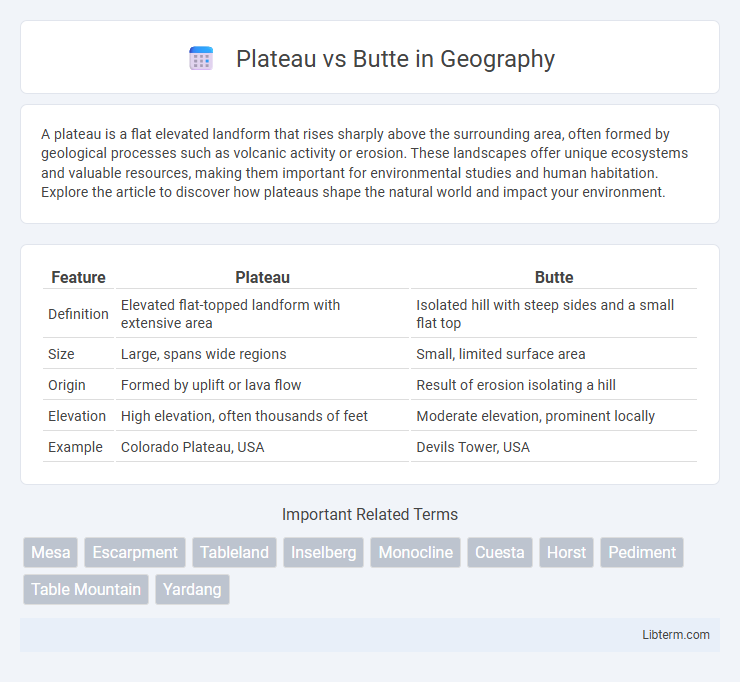A plateau is a flat elevated landform that rises sharply above the surrounding area, often formed by geological processes such as volcanic activity or erosion. These landscapes offer unique ecosystems and valuable resources, making them important for environmental studies and human habitation. Explore the article to discover how plateaus shape the natural world and impact your environment.
Table of Comparison
| Feature | Plateau | Butte |
|---|---|---|
| Definition | Elevated flat-topped landform with extensive area | Isolated hill with steep sides and a small flat top |
| Size | Large, spans wide regions | Small, limited surface area |
| Origin | Formed by uplift or lava flow | Result of erosion isolating a hill |
| Elevation | High elevation, often thousands of feet | Moderate elevation, prominent locally |
| Example | Colorado Plateau, USA | Devils Tower, USA |
Understanding Plateaus and Buttes
Plateaus are broad, elevated landforms with flat tops and steep sides, often formed by tectonic activity or volcanic eruptions, covering extensive areas like the Colorado Plateau. Buttes are smaller, isolated hills with steep, often vertical sides and a flat top, typically resulting from erosion processes that wear away surrounding softer rock layers, such as the famous Devil's Tower in Wyoming. Understanding the difference between plateaus and buttes involves recognizing their size, formation mechanisms, and geological features shaping their distinct landscapes.
Geographical Definitions: Plateau vs Butte
A plateau is an extensive flat-topped elevated landform that rises sharply above the surrounding area, often formed by tectonic uplift or volcanic activity, spanning large regions with relatively level surfaces. A butte is a smaller, isolated hill with steep, often vertical sides and a flat top, typically resulting from erosion that leaves behind resistant rock layers. Both features differ primarily in their size and formation processes, with plateaus covering broad areas and buttes serving as prominent, solitary remnants of eroded plateaus or mesas.
Key Formation Processes
Plateaus form through extensive volcanic activity or the uplift of large land surfaces by tectonic forces, resulting in broad, flat elevated areas. Buttes develop primarily from the erosion of mesas or plateaus, where wind and water selectively wear away softer rock layers, leaving isolated steep-sided hills with a flat top. The differential erosion and rock resistance significantly define butte formation compared to the tectonic uplift or lava accumulation processes that create plateaus.
Distinguishing Features of Plateaus
Plateaus are expansive, elevated flatlands that rise sharply above the surrounding terrain, characterized by their broad, level surfaces and significant altitude. Unlike buttes, which are isolated hills with steep, often vertical sides and a small summit area, plateaus cover wide areas and feature gradual slopes on at least some edges. The distinguishing features of plateaus include vast horizontal extent, uniform height, and a landscape shaped by tectonic uplift or volcanic activity.
Unique Characteristics of Buttes
Buttes are isolated hills with steep, often vertical sides and a small, flat top, distinguishing them from broader plateaus. Their erosion-resistant caprock protects the summit, creating a striking contrast with the surrounding landscape. Typically smaller than mesas and plateaus, buttes serve as prominent geological landmarks in arid and semi-arid regions.
Global Examples of Plateaus
Plateaus are extensive flat elevated landforms that rise sharply above surrounding areas, with prominent global examples including the Deccan Plateau in India, the Colorado Plateau in the United States, and the Tibetan Plateau in Asia, the latter being the highest and largest plateau worldwide. Buttes, in contrast, are isolated hills with steep, often vertical sides and a small summit area, typically found in arid regions like the southwestern United States but on a much smaller scale than plateaus. Understanding these landforms enhances geological and geographical knowledge by highlighting the distinct formation processes and sizes between vast plateaus and smaller, more localized buttes.
Famous Buttes Around the World
Famous buttes such as Monument Valley's East and West Mitten Buttes in the United States showcase towering, isolated rock formations that distinctly rise from flat plains, contrasting sharply with broader, elevated plateaus like the Colorado Plateau. Buttes, characterized by their steep sides and a flat top, are smaller and more striking in silhouette compared to plateaus, which cover extensive areas. Iconic global examples include the Devil's Tower in Wyoming and Uluru in Australia, both celebrated for their unique geological features and cultural significance.
Ecological Roles and Biodiversity
Plateaus support diverse ecosystems by providing extensive flat habitats that host various plant and animal species, often including unique microclimates and soil types. Buttes, with their isolated and elevated nature, serve as refuges for rare and specialized species, contributing to biodiversity hotspots in arid and semi-arid regions. Both landforms play significant ecological roles by influencing local climate patterns, water runoff, and serving as critical habitats that maintain regional biodiversity.
Human Interaction and Cultural Significance
Plateaus often serve as strategic locations for agriculture, settlements, and transportation routes due to their expansive flat terrain, supporting diverse human activities and cultural development over millennia. Buttes, with their isolated and prominent features, frequently hold spiritual significance and are used as landmarks or ceremonial sites by indigenous communities. Both landforms shape regional identity and influence patterns of human interaction through their unique physical presence and cultural associations.
Comparative Summary: Plateau vs Butte
A plateau is an extensive, elevated flat-topped landform with significant horizontal area, while a butte is a smaller, isolated hill with steep, often vertical sides and a flat or rounded top. Plateaus generally form through broad uplift or volcanic activity, contrasting with buttes that result from erosion removing surrounding softer rock. The key difference lies in size and formation processes, with plateaus covering large regions and buttes appearing as solitary remnants of larger landforms.
Plateau Infographic

 libterm.com
libterm.com